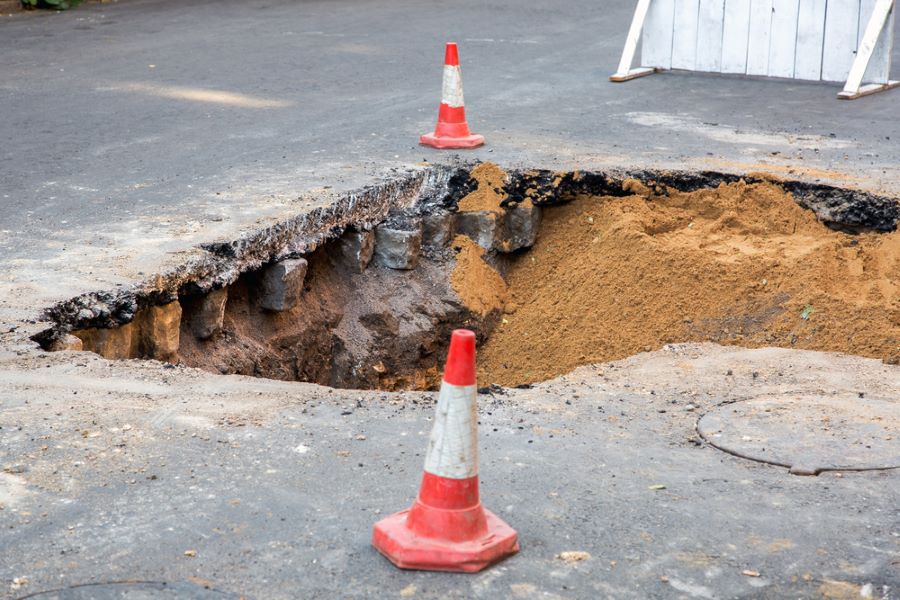Sinkholes can be unforgiving when it comes to deterring motorists and drivers from going about their days. These huge holes seemingly appearing out of nowhere can cause delays and even road closures, but do you know what causes sinkholes in roads?
In 2024, a lot of people pulled up to a shutdown on Sales Road, Pasay City due to a sinkhole. But don’t worry, this sinkhole wasn’t as scary as the ones you see on TV where it swallows up entire vehicles. Those huge sinkholes are rare, more often than not small sinkholes are more frequently encountered.
In fact, the sinkhole in Pasay City was just one among many of the sinkholes that occurred in the Philippines. All over the country, sinkholes have appeared out of nowhere and have intruded on daily lives, some have even resulted in fatalities, which is why it’s important to understand why these occurrences can happen and how to prevent them.
In this article, we’ll tell you everything you need to know about sinkholes from their causes, which asphalt mix to use to repair them, and how to prevent them.

What is a Sinkhole?
Sinkholes are naturally occurring phenomena that occur when a subsurface material is removed or weakened. This commonly happens when water eats away at the layers of the road or when road reinforcements are no longer strong enough to tide over incoming traffic.
Road sinkholes are often 3 meters in diameter, but sometimes they can be bigger.
Why are Sinkholes a Problem?
Much like any natural disaster, sinkholes can be unpredictable which can lead to endangering the lives of many.
Here are some of the reasons why sinkholes are dangerous:
- Sudden road collapse can lead to injuries and fatal accidents for drivers, motorists, and pedestrians.
- Disrupt the flow of traffic and cause road closures delaying individuals from reaching their destinations.
- Damage road foundations which can lead to heft repair bills.
- Contaminate underground water sources and introduce foreign materials and dangerous bacteria into these sources.
- Negatively impact businesses located around the area because of these phenomena.
- Underground sewer lines and power cables can lead to service disruptions.

What Causes Sinkholes in Roads?
In the Philippines, sinkholes can occur for a myriad of reasons such as:
- Water washing away road foundations
- Poor infrastructure building (ex. lack of reinforcements in key road areas)
- Lowering of groundwater
- Heavy loads on the surface
- Seasonal changes in the groundwater (ex. La Niña)
- Disturbance of Soil
- Concentration of water flow
- Water impoundments (ex. dams)
- Drilling
How to Fix Sinkholes?
If there’s a sinkhole in your area, you can expect the road to be shut down for the time being as the contractors fix the issue.
Before a sinkhole is repaired, it must first be assessed by professionals to determine the cause of this breakdown and to come up with an appropriate repair plan. Then, the cavity must be repaired using different materials such as rocks, gravel, and soil. Afterward, the ground must be stabilized to ensure that this type of collapse won’t happen again.
Once ground stabilization operations have been performed, the surface must be repaired using hot mix asphalt or cold patch asphalt, depending on the damage. A high-quality asphalt crack filler must also be utilized to minimize the risk of water seepage once again. In some cases, a full road reconstruction may be required if the damage is severe.
Can Sinkholes Be Prevented and How to Prevent Them?
It’s normal to feel helpless and fearful of sinkholes, especially since you don’t know what to do when one pops up. However, road sinkholes can be prevented through proper maintenance.
For example, the sinkhole in Pasay in 2024 was caused by a leak from the pipeline. That being said, Maynilad is being held liable for being unable to provide regular inspection and maintenance of their project.
Another example is Boracay. Boracay has over 800 sinkholes around the island because the island is made of limestone. So, to prevent more sinkholes from forming, the LGU is recommending that everyone follow the island’s carrying capacity.
Sinkhole prevention relies greatly on the proper monitoring, maintenance, and implementation of protocols. Although, it’s still good to remember that preventing sinkholes can be a team effort, so knowing the warning signs is key to preventing them:
- Doors and windows cannot close properly
- Cracks in the road foundation
- Circular cracks
- Stressed vegetation due to lowered water table
We hope that you learned all about sinkholes and that we’ve eased some of your fears. Remember that sinkholes are preventable and that they can also be repaired, but a key part in prevention is detection. So, if you see any signs of sinkhole formation, make sure to alert your LGU so they can investigate these claims immediately.



